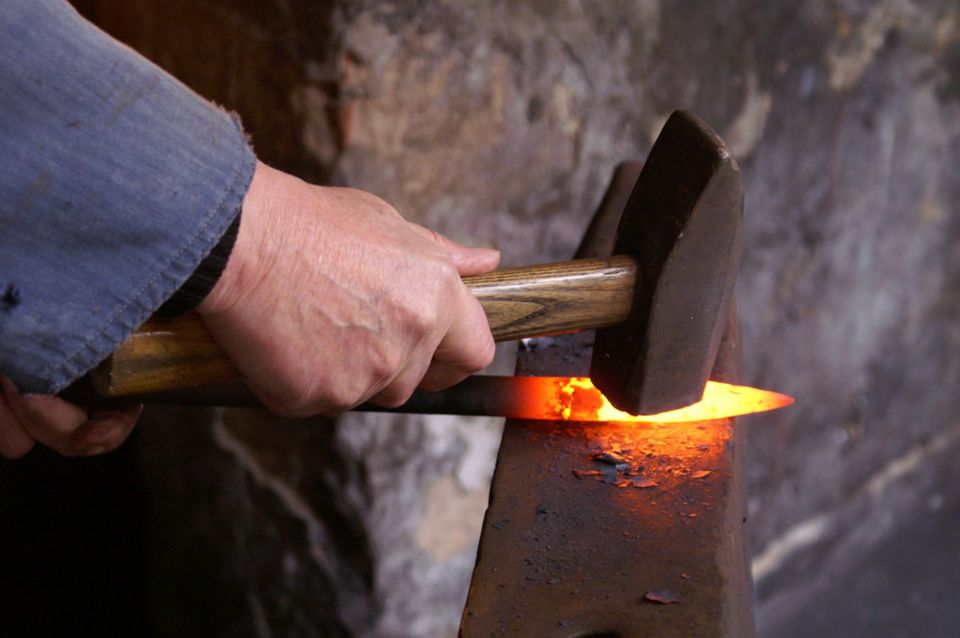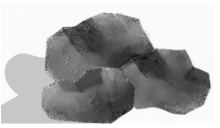The Discovery of Iron

It hit. He discovered something. Something that could change the world. Then began the evaluation of an age. The age we still haven't left today. The age that marked the end of the bronze age. This discovery played a big role in the history of humanity.
A thousand years ago, while a man was inspecting a meteorite that hit the earth he discovered something that could change the world. He discovered a chemical element with the symbol Fe and atomic number 26, an element stronger than copper called iron. From the iron, the man developed a variety of tools and weapons such as axes, ploughs, sickles, shovels, spears, etc. With the use of tools and weapons the man could cut trees, till the land and kill big animals easily. Iron tools and weapons weren't as hard or durable as their bronze counterparts. But the use of iron became more widespread after people learned how to make steel, a much harder metal, by heating iron with carbon. This discovery made a big difference to the world. Men in different parts of the world started living in villages and kept on improving the tools and weapons made from iron. They developed many skills and occupations. Now humans could work as a blacksmith, carpenters, farmers, hunters and potters. Each discovery and invention led to a more comfortable life.
Iron is shiny and metallic with a grey tinge. It is solid and heavy. As it oxidizes (rusts) it becomes a distinctive reddish brown. Iron is usually solid and it needs to be extremely hot to melt. The Latin name for iron is Ferrum. The word iron is from an Anglo-Saxon word, iren. The word iron is may be derived from earlier words meaning "holy metal" because it was used to make the swords used in the Crusades, according to WebElements. Iron is an enigma – it rusts easily, yet it is the most important of all metals. 90% of all metal that is refined today is iron. Most are used to manufacture steel, used in civil engineering (reinforced concrete, girders etc) and in manufacturing.

In Mesopotamian Civilization there is evidence that people were smelting iron around 5000 BC. Artefacts made of smelted iron have been found from about 3000 BC in Egypt and Mesopotamia. The earliest-known iron artefacts are nine small beads dated to 320 BC, which were found in burials at Gerzeh, Lower Egypt. They have been identified as meteoric iron shaped by careful hammering. After this discovery, then began the evolution of the iron age. The Iron Age was a period in human history that started between (depending on the region) 1200 B.C. and ended in 332 B.C. and followed the Stone Age and Bronze Age. During the Iron Age, people across most of Europe, Asia and parts of Africa began making tools and weapons from iron and steel.
The Iron Age helped many countries to become more advanced in technology. Iron made life a lot easier in those days when just living to the age of 45 was a feat. By that time, much of Europe had settled into small village life, toiling the soil with bronze and stone tools. Metalwork made tasks like farming easier, as the iron tools were much better than what the people had before. During the Iron Age, farmers used an 'ard' (an iron plough) to turn over their fields. Iron farming tools, such as sickles and plough tips, made the process more efficient and allowed farmers to exploit tougher soils, try new crops and have more time for other activities.
Some suggest that we still haven't yet left the iron age. But now we all know that the iron age played a big role in the history of humanity as the manufacture of iron triggered the advancement of the agricultural and military sectors, followed by rapid production growth and the industrial revolution. And that we all should remember.
Fun Facts about Iron:
- Iron is the second most abundant of all metals on Earth.
- Iron is the fourth most common element by mass.
- Iron is the main component of meteorites.
- Iron's scientific name is ferrum.
- In history, iron describes an entire period of human development.
- You can't make steel without iron.
- Not all iron is magnetic
- Iron is a chemical element on the periodic table.
- Pure iron is a soft metal with a greyish colour.
- Iron was most likely first discovered before the 5th millennium BC (5000 BC).
- Iron is a solid at room temperature.
- The symbol for iron is Fe.
- The atomic number for iron is 26.
References
https://www.history.com/topics/pre-history/iron-age
https://en.wikipedia.org/wiki/Iron_Age
Author biography
Aisha is a 13 year old student of the 7th grade and a current member of the Leaders of Tomorrow programme by Professor Ugail. Her hobby is cooking. She is one of the best players in the school basketball, netball and handball teams. Aisha loves reading and writing adventure and mystery books. She also creates beautiful artworks and poems. Her goal is to become a technician and a teacher.

Cite this article as:
Aisha Binth Asif Mohamed, The Discovery of Iron, theCircle Composition, Volume 1, (2021). https://thecirclecomposition.org/the-discovery-of-iron/
